AUDI Q3 2018 Owners Manual
Manufacturer: AUDI, Model Year: 2018, Model line: Q3, Model: AUDI Q3 2018Pages: 230, PDF Size: 57.03 MB
Page 111 of 230
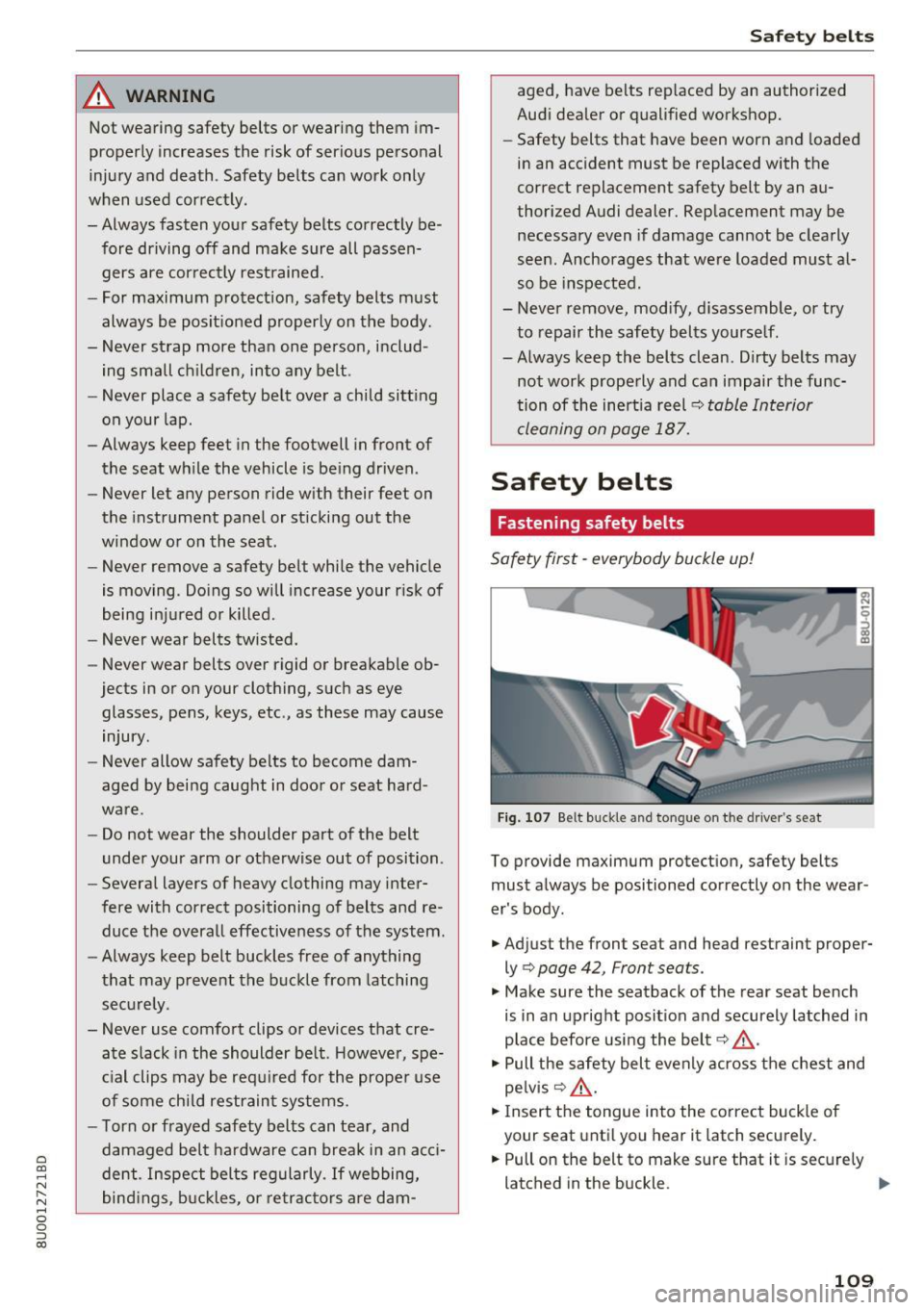
a
co
...... N r--. N
'"' 0 0 ::, co
A WARNING
Not wearing safety belts or wearing them im
properly increases the risk of serious personal
injury and death. Safety belts can work only
when used correctly.
-Always fasten your safety belts correctly be fore driving off and make sure all passen
gers are correctly restrained.
- For maximum protection, safety belts must
always be positioned properly on the body.
- Never strap more than one person, includ
ing small children, into any belt.
- Never place a safety belt over a child sitting
on your lap.
- Always keep feet in the footwell in front of
the seat while the vehicle is being driven.
- Never let any person ride with their feet on
the instrument panel or sticking out the
window or on the seat.
- Never remove a safety belt while the vehicle
is moving . Doing so will increase your risk of
being injured or killed.
- Never wear belts twisted.
- Never wear belts over rigid or breakable ob-
jects in or on your clothing , such as eye
glasses, pens, keys, etc., as these may cause
injury.
- Never allow safety belts to become dam
aged by being caught in door or seat hard
ware.
- Do not wear the shoulder part of the belt
under your arm or otherwise out of position .
- Several layers of heavy clothing may inter
fere with correct positioning of belts and re
duce the overall effectiveness of the system.
- Always keep belt buckles free of anything
that may prevent the buckle from latching
securely .
- Never use comfort clips or devices that cre
ate slack in the shoulder belt. However, spe
cial clips may be required for the proper use
of some child restraint systems.
- Torn or frayed safety belts can tear, and
damaged belt hardware can break in an acci
dent. Inspect belts regularly.
If webbing,
bindings, buckles, or retractors are dam-
Safety belts
aged, have belts replaced by an authorized
Audi dealer or qualified workshop.
- Safety belts that have been worn and loaded
in an accident must be replaced with the
correct replacement safety belt by an au
thor ized Audi dealer. Replacement may be
necessary even if damage cannot be clearly
seen. Anchorages that were loaded must al
so be inspected.
- Never remove, modify, disassemble, or try
to repair the safety belts yourself.
-Always keep the belts clean. Dirty belts may not work properly and can impair the func
tion of the inertia reel~
table Interior
cleaning on page 187.
Safety belts
Fastening safety belts
Safety first -everybody buckle up!
Fig. 107 Belt buckle and tongue on t he driver 's seat
To provide maximum protection, safety belts
must always be positioned correctly on the wear
er's body .
.. Adjust the front seat and head restraint proper
ly ¢
page 42, Front seats.
.. Make sure the seatback of the rear seat bench
is in an upright position and securely latched in
place before using the belt¢,&. .
.. Pull the safety belt evenly across the chest and
pelvis¢ ,&. .
.. Ins ert the tongue into the correct buckle of
your seat until you hear it latch securely.
.. Pull on the belt to make sure that it is securely
latched in the buckle .
IIJ,,
109
Page 112 of 230
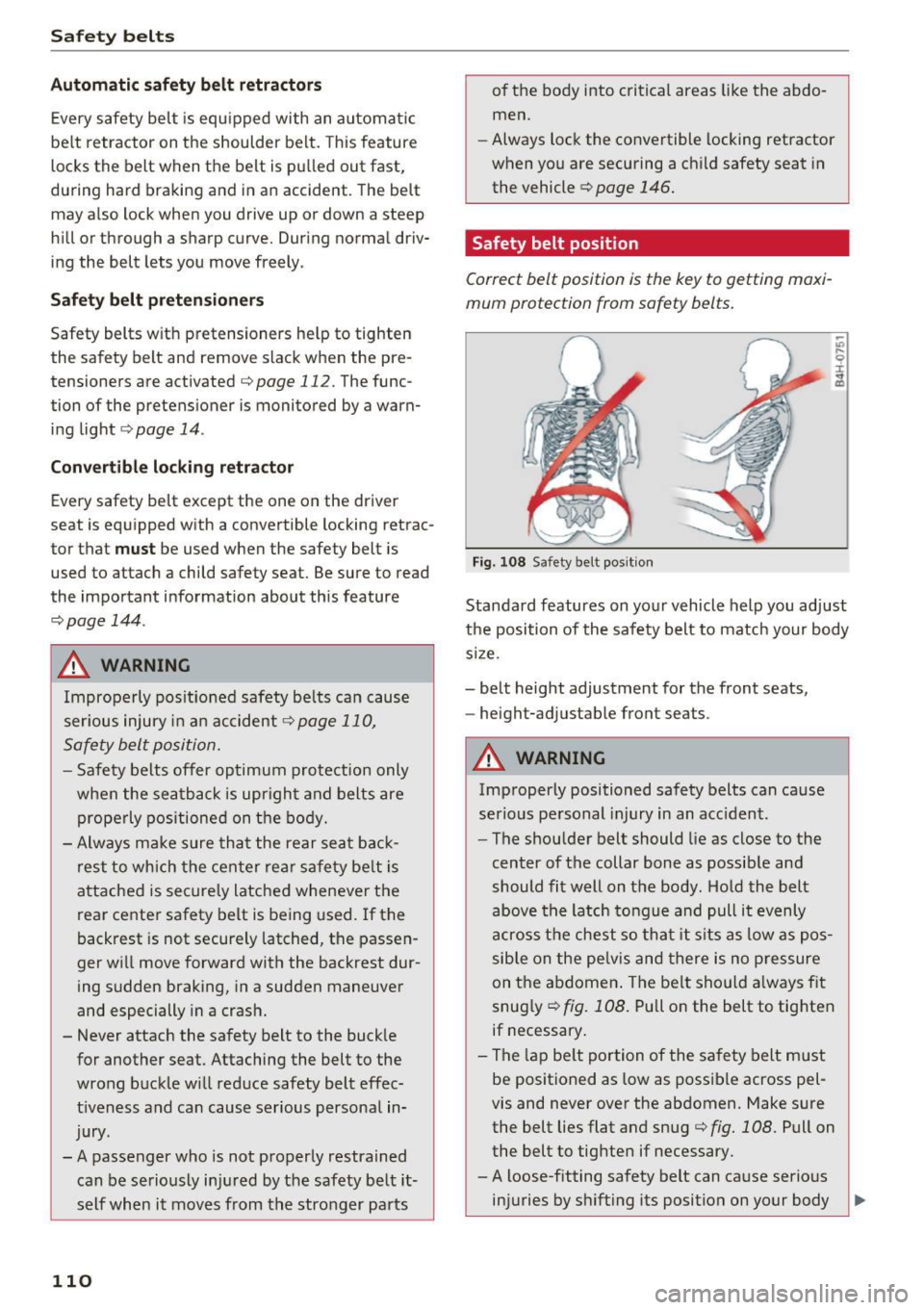
Safe ty belts
Autom ati c s afet y belt retr actors
Every safety belt is equ ipped with an automa tic
be lt retractor on the shoulder belt. This feature
locks the belt when the belt is pulled out fast,
during hard braking and in a n accident . The belt
may a lso lock when you drive up or down a steep
hill or through a sharp curve. Dur ing normal driv
ing the belt lets you
move freely .
Safety belt p ret en sion ers
Safety belts w ith pretensioners he lp to tighten
the safety belt and remove s lack when the pre
tensioners are activated ¢
page 112. The func
tion of the pretensioner is monitored by a warn ing light
¢ page 14.
Con vertib le loc king retract or
Every safety belt except the one on the driver
seat is equipped with a convertible locking retrac
tor that
m ust be used when the safety belt is
used to attach a child safety seat. Be sure to read
the impo rtant information about this feature
¢ page 144.
.&_ WARNING
Improperly pos itioned safety be lts can cause
ser ious injury in an accident
¢page 110,
Safety belt position.
- Safety belts offer optimum protection only
when the seatback is upright and belts are
properly positioned on the body.
- Always make sure that the rear seat bac k
rest to which the center rea r safety belt is
attached is secure ly latched whenever the
rear center safety belt is being used. If the
backrest is not securely latched, the passen
ger will move forward with the backrest dur
ing sudden braking, in a sudden maneuver
and especially in a crash.
- Never attach the safety belt to the buckle for another seat. Attaching the belt to the
wrong buckle wi ll reduce safety belt effec
t iveness and can cause serious persona l in
jury.
- A passenger who is not properly restrained can be seriously in ju red by the safety be lt it
self when it moves from the stronger parts
110
of the body into critical areas like the abdo men.
- Always lock the convertible locking retractor
when you are securing a child safety seat in
the vehicle ¢
page 146.
Safety belt position
Correct belt position is the key to getting maxi
mum protection from safety belts .
Fig. 108 Safety belt pos it ion
-"' .... 9 I ... a,
Standard features on your vehicle help you adjust
the position of the safety belt to match your body
s ize.
- belt height adjustment for the front seats,
- height-adjustab le front seats .
.&_ WARNING
Improperly positioned safety belts can cause
serious personal injury in an acc ident .
- The shoulder belt should lie as close to the
center of the collar bone as possib le and
should fit well on the body. Hold the belt
above the latch tongue and pull it evenly
across the chest so that it s its as low as pos
sib le on the pe lvis and there is no p ressure
on the a bdomen . The belt sho uld a lways f it
snug ly ¢
fig. 108. Pull on the belt to tig hten
if necessary .
- The lap be lt portion of the safety belt must
be positioned as low as possible across pel
vis and never
over the abdomen. Make sure
the belt lies flat and snug ¢
fig. 108. Pull on
the belt to tighten if necessary.
- A loose-fitting safety belt can ca use serious
injuries by sh ifting its position on your body ..,_
Page 113 of 230
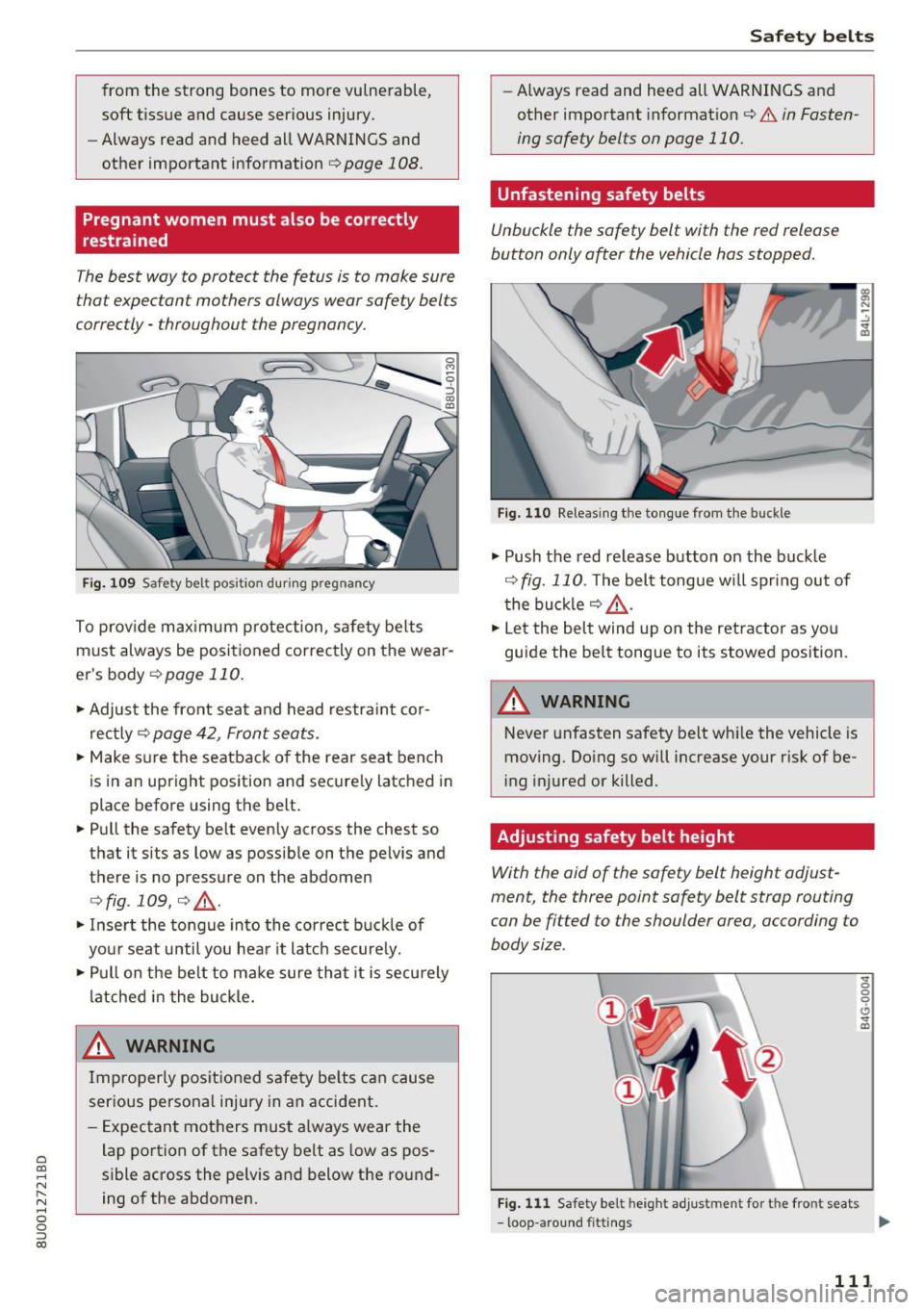
a
co
...... N r--. N .-< 0 0 ::, co
from the strong bones to more vulnerable,
soft tissue and cause serious injury.
- Always read and heed all WARNINGS and
other important information
9 page 108.
Pregnant women must also be correctly
restrained
T he best way to protect the fetus is to make sure
tha t expec tan t mothers always wear safe ty bel ts
correctly -throughou t the pregnancy .
Fig. 10 9 Safety be lt pos itio n durin g p reg nancy
To p rov ide max imum p rotection, safety belts
must always be positioned correctly on the wear
e r's body
c::> page 110 .
• Adjus t the front seat and head restra int cor
rec tly
c::> page 42 , Front seats .
• Make s ure the seatback of the rear seat bench
is in a n upright position and secure ly latched in
place before using th e belt.
• Pull the safety belt evenly across the chest so
that it sits a s low as possible on the pelv is and
there is no pressure on the abdomen
c::> fig . 109, c::> .&_ .
• Inse rt the to ngue into the cor rec t buckle of
you r seat until you hea r it latch secure ly .
• Pullon the belt to m ake sure that it is secu rely
latched in the bu ckle.
_& WARNING
Improperly posit ioned safety be lts ca n cause
serious personal inj ury in an accident .
- E xpec tant mot hers mus t always wear the
lap portion of the safety belt as low as pos
sible across the pelvis and below the ro und
ing of the abdomen .
Safety bel ts
-Always read and heed all WARNINGS and
other important informat ion
c::> A in Fasten
ing safety belts on page 110.
Unfastening safety belts
Unbuckle the safety belt with the red release
button only o~er the vehicle has stopped.
Fig. 1 10 Releasi ng t he to ngue from t he bu ckle
.,. Push the red re lease but ton on the buck le
c::> fig. 110 . The belt tongue w ill spr ing out of
t he buck le
c::> _&. .
• Let the belt wind up on the retra ctor as yo u
guide the belt tongue to its stowed posit ion.
_& WARNING
Never unfasten safety belt whi le the vehicle is
moving . Do ing so will increase your r isk of be
i ng injured or killed .
Adjusting safety belt height
With the aid of the safety belt height adjust
ment, the three point safety belt strap rout ing
can be fi tted to the shoulder area, according to
body size .
Fig. 11 1 Safety belt height a dju stm ent fo r th e fro nt seat s
... 0 0
0
6 ... a,
-loop -a ro und fitt ings Ill>
111
Page 114 of 230
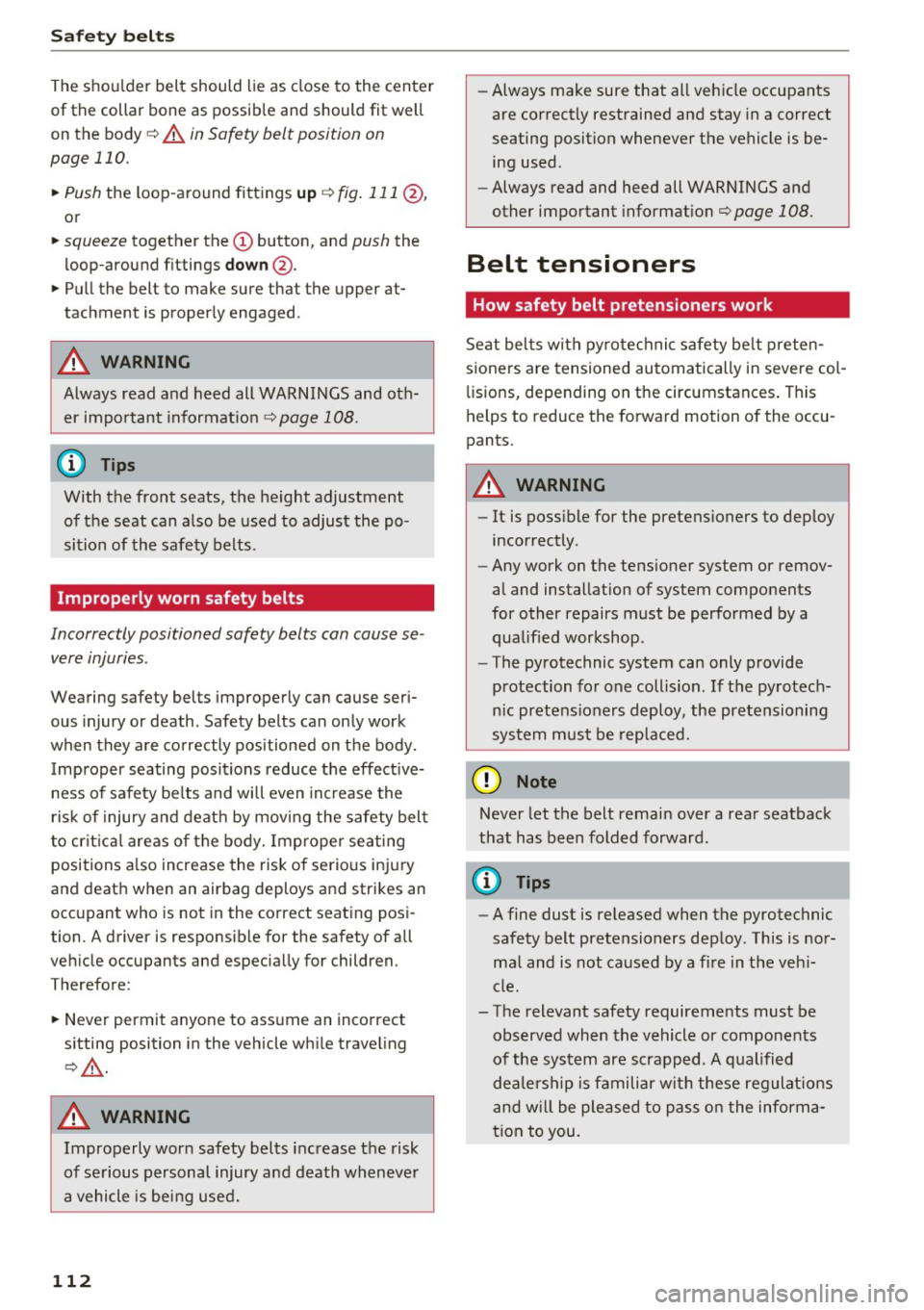
Safety belts
The shou lder belt should lie as close to the center
of th e collar bone as possib le and should fit well
on the body
c::> A in Safety belt position on
page 110.
"' Push
the loop -a round fittings up c::> fig. 111 @ ,
or
"'squeez e together the (D button, and push the
loop-around fittings down@.
"'Pull the belt to m ake sure that the upper at
tachment is properly engaged .
A WARNING
Always read and heed all WARNINGS and oth er important informat ion
c::> page 108.
(D Tips
With the front seats, the height adjustment of the seat can also be used to adjust the po
sition of the safety belts.
Improperly worn safety belts
Incorrectly positioned safety belts can cause se
vere injuries .
Wearing safety belts improperly can cause seri
ous injury or death . Safety belts can only work
when they are correctly positioned on the body.
Improper seating positions reduce the effect ive
ness of safety belts and will even inc rease the
risk of injury and death by mov ing the safety belt
to cr it ica l areas of the body. Improper seating
positions a lso increase the risk of serious injury
and death when an airbag deploys and strikes an
occupant who is not in the correct seating pos i
tion . A drive r is responsible for the safety of all
veh icle occupants and especially for children.
Therefore :
"' Never permit anyon e to assume an incorrect
sitting position in the vehicle while traveling
c>_& .
A WARNING
Improperly worn safety belts increase the risk
of serious personal injury and death whenever
a vehicle is being used.
112
- Always make sure that all vehicle occupants
are correctly restrained and stay in a correct
seating position whenever the vehicle is be
ing used.
- Always read and heed all WARNINGS and
other important informat ion
c::> page 108 .
Belt tensioners
How safety belt pretensioners work
Seat belts with pyrotechnic safety be lt preten
sioners are tensioned automatically in severe col
lisions, depending on the circumstances . This
helps to reduce the forward motion of the occu
pants.
A WARNING
- It is possible for the pretensioners to deploy
incorrectly .
- Any work on the tensioner system or remov
al and installation of system components
for other repairs must be performed by a qualified workshop .
- The pyrotechnic system can only provide
protection for one collision.
If the pyrotech
nic pretens ioners deploy, the pretensioning
system must be replaced.
(D Note
Never let the belt remain over a rear seatback
that has been folded forward.
(D Tips
- A fine dust is released when the pyrotechnic
safety belt pretensioners deploy . This is nor
mal and is not caused by a fire in the veh i
cle.
- The relevant safety requirements must be
observed when the vehicle or components
of the system are scrapped . A qualified
dealership is familiar with these regulations
and will be pleased to pass on the informa
tion to you.
Page 115 of 230
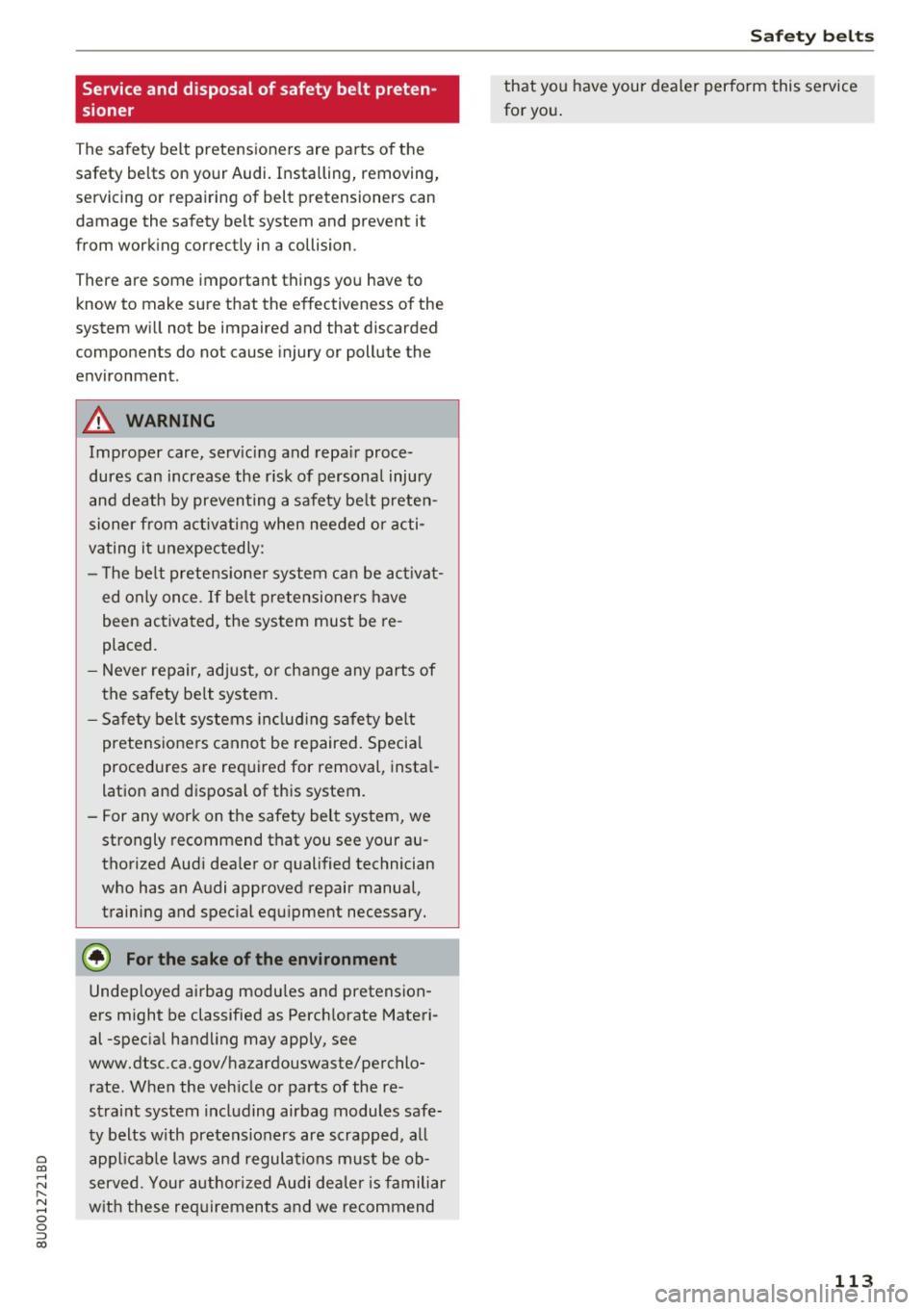
0 co ......
"' ,....
"' ...... 0 0 :::,
00
Service and disposal of safety belt preten
sioner
The safety belt pretens ioners are parts of the
safety be lts on your Audi. Installing, removing,
servicing or repairing of belt pretensioners can
damage the safety belt system and prevent it
from working correctly in a collision .
There are some important things you have to know to make sure that the effectiveness of the
system w ill not be impaired and that discarded
components do not cause injury or pollute the
environment.
A WARNING
-
Improper care, serv icing and repa ir proce
dures can increase the r isk of personal injury
and death by preven ting a safety be lt preten
sioner from activating when needed or acti
vating it unexpectedly:
- T he be lt pretensione r system can be act ivat
ed only once.
If belt pretensioners have
been ac tiva ted, the system must be re
placed.
- Never repair, adjust, or ch ange any parts of
the safety be lt system .
- Safety belt systems in cl ud ing safety belt
pretens ioners cannot be repaired. Specia l
procedures are req uired for removal, insta l
lation and disposa l of this system.
- For any work on the safety bel t system, we
strongly recommend that you see your au
thorized Aud i dea ler or qualified technician
who has an A udi approved repair manual,
train ing and spec ial equ ipment necessary.
@ For the sake of the environment
Undep loyed airbag modu les and pretension
ers might be classified as Perch lorate Materi
al -spec ia l handling may apply, see
www.dtsc.ca.gov/hazardouswaste/perchlo rate. When the veh icle or parts of the re
straint system including air bag modules safe
ty belts with pretensioners are scrapped, all
app licabl e laws and regula tions must be ob
served. Your authorized Audi dealer is familiar
w it h these req uirements and we recommend
S afet y be lts
that you have your dealer perform this service
for you .
113
Page 116 of 230
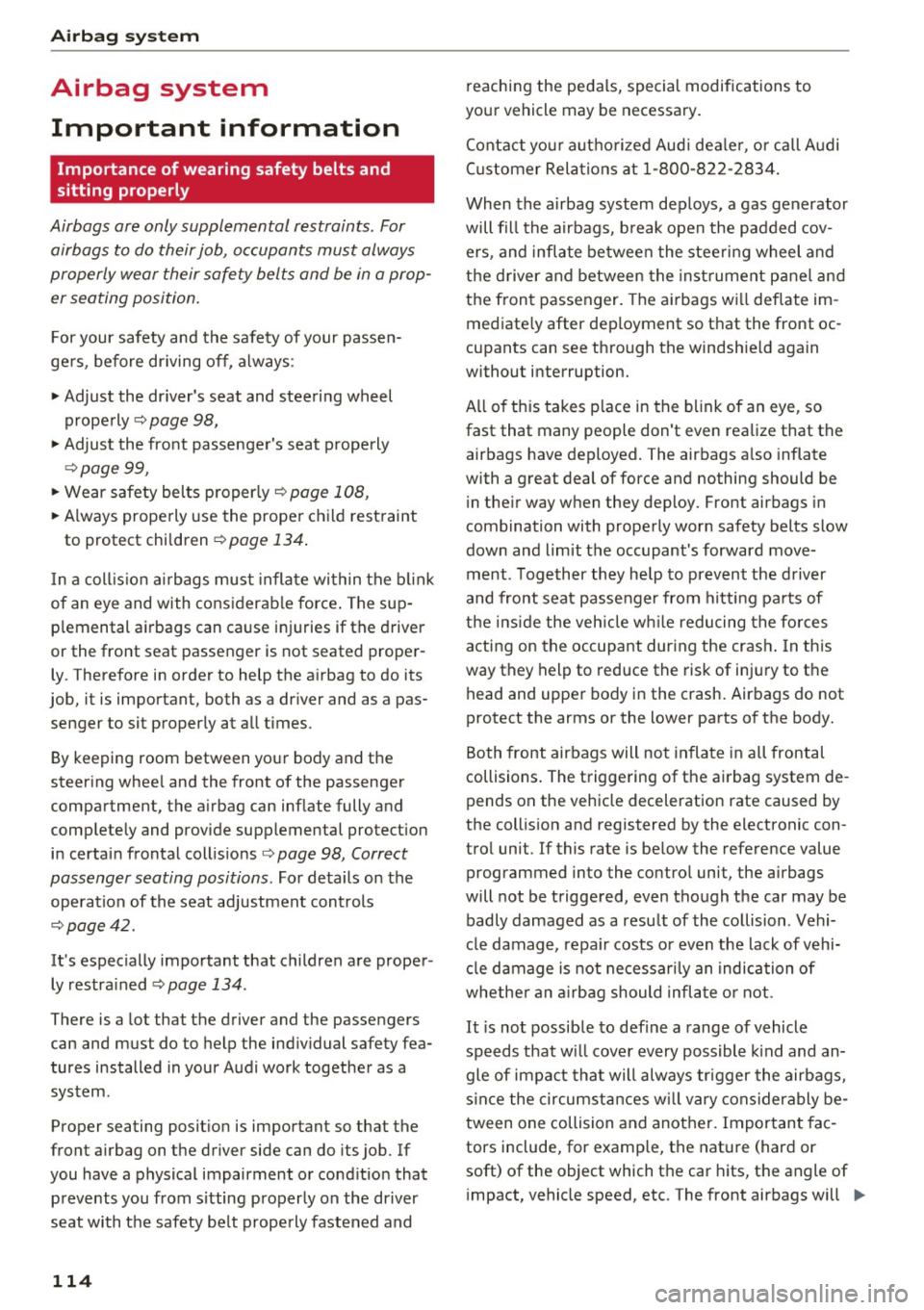
Airbag syste m
Airbag system
Important information
Importance of wearing safety belts and
sitting properly
Airbags are only supplemental restraints . For
airbags to do their job, occupants must always
properly wear their safety belts and be in a prop
er seating position.
For your safety and the safety of your passen
ge rs , before driving off, always :
"' Adjust the driver's seat and steering wheel
properly ¢
page 98,
"'Adjust the front passenge r's seat properly
¢ page 99,
"'Wear safety belts p roperly ¢ page 108 ,
"'Always properly use the proper child restraint
to protect children ¢
page 134.
In a coll is io n ai rbags must inflate wi thin the b link
of an eye and with cons iderable force . The sup
p lemental airbags can ca use injuries if the driver
or the front seat passenger is not seated proper·
Ly. T herefore in order to help the airbag to do its
job, it is important, both as a dr iver and as a pas
senger to sit properly at all t imes .
By keeping room between yo ur body and the
steering whee l and the front of the passenger
compartment, the a irbag can inflate fully and
completely and provide supplemental protect ion
in certain frontal collis ions ¢
page 98, Correct
passenger seating positions .
For details on the
operation of the seat adjustment controls
¢ page 42.
It's especially important that children a re proper
ly restra ined
¢ page 134 .
There is a lot that the driver and the passengers
can and must do to help the ind iv idual safety fea
tures installed in your Audi work together as a
system .
Proper seating posit ion is important so that the
front airbag on the drive r side can do its job. If
you have a physical impairment or cond ition that
prevents you from s itting properly on the driver
seat with the safety be lt properly fastened and
114
reaching the peda ls, special modifications to
your vehicle may be necessary.
Contact yo ur autho rized Aud i dea le r, or call A udi
C u stomer Rela tions at 1-800 -82 2-2834.
When the airbag system dep loys, a gas generator
will fill the airbags, b reak open the padded cov
ers, and inflate betwee n the steeri ng wheel and
the driver and between the inst rument panel and
the front passenger . The a irbags w ill deflate im
mediate ly after dep loyment so t hat the front oc
cupants can see through the windsh ie ld again
without interruption.
A ll of th is takes p lace in the blink of an eye, so
fast that many people don't even realize that the
airbags have deployed. The airbags a lso inflate
with a great deal of force and nothing should be i n the ir way when they deploy. Front airbags in
combination with properly worn safety belts slow
down and lim it the occupant's forward move
ment . T ogether they he lp to prevent the driver
a nd front seat passenger from h itti ng pa rts of
t h e inside the veh icle w hile reducing the fo rces
acti ng on the occupant dur ing the cras h. In th is
way they help to reduce the risk of inju ry to the
head and uppe r body i n the crash. Airbags do not
protect the arms or the lower parts of the body.
Both front airbags will not inflate in all frontal
collisions. The trigge ring of the airbag system de
pends on the vehicle deceleration rate caused by
the collis ion and registered by the electronic con
tro l unit . If this rate is below the reference value
programmed into the contro l unit, the airbags
will not be trigge red, even though the car may be
badly damaged as a resu lt of the co llision . Vehi
cle damage, repa ir costs or even the lack of vehi
cl e damage is not necessari ly an indica tion of
whethe r an a irbag should inflate o r not.
It is not possib le to define a range of vehicle
speeds that w ill cove r every possible k ind and an
gle of impa ct that will always tr igger the airbags,
s ince the circumst ances w ill vary cons iderably be
tween one collision and another. Important fac
tors include, for example, the natu re (hard or
soft) of the object which the car hits, the angl e of
i mpact, vehicle speed, etc . The front airbags will ..,_
Page 117 of 230
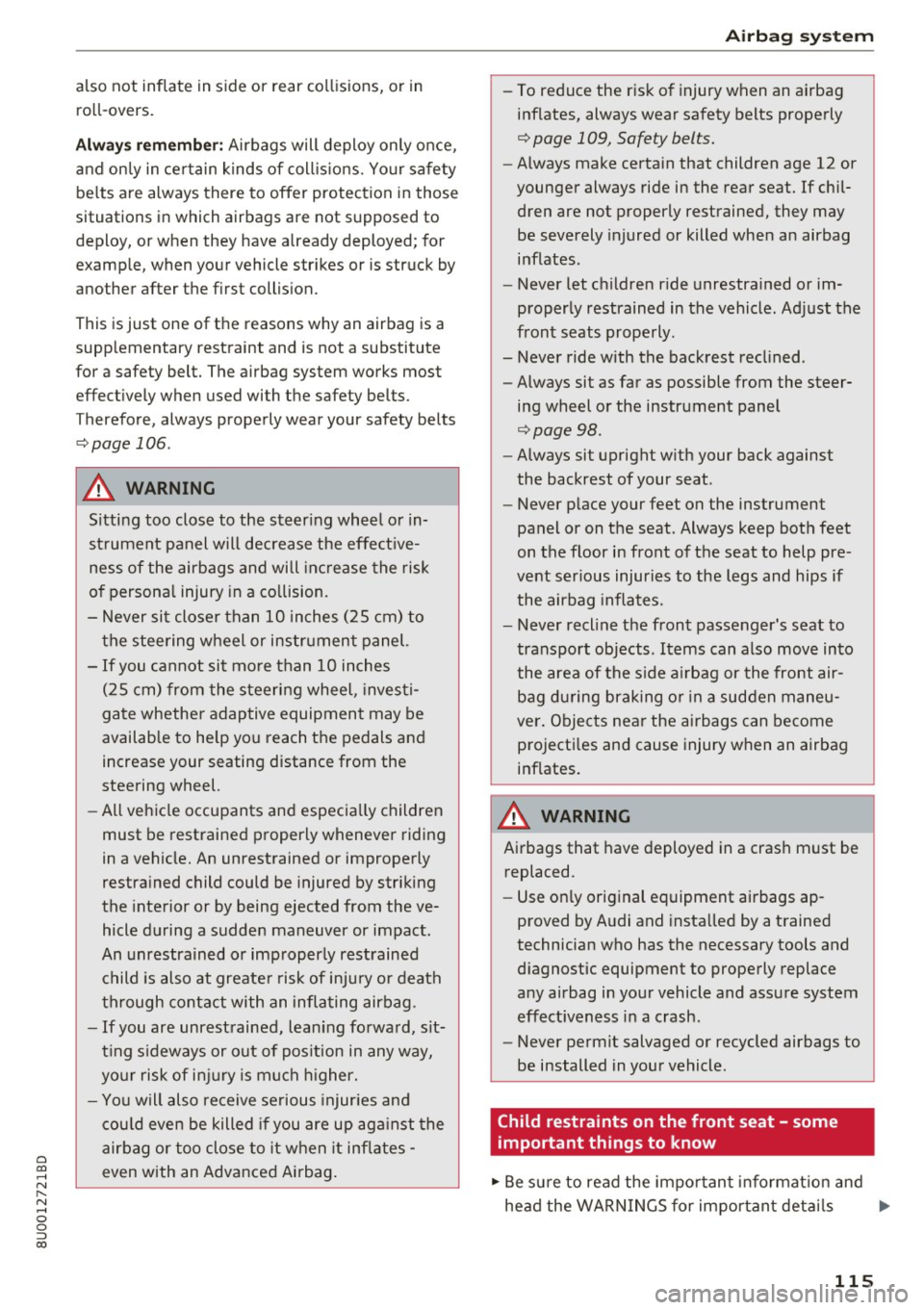
0 co ......
"' ,....
"' ...... 0 0 :::,
00
also not inflate in side or rear coll isions, or in
ro ll-overs.
A lwa ys rememb er: Airbags will deploy only o nce,
and on ly in certain kinds of coll is ions. Your safety
be lts are always there to offer protection in those
situations in which airbags are not supposed to
deploy, or when they have a lready deployed; for
examp le, when your vehicle str ikes or is struck by
another after the first collis ion.
This is just one of the reasons why an airbag is a
supp lementary restraint and is not a substitute
for a safety belt. The airbag system works most effect ively when used with the safety belts.
Therefore, always properly wear your safety belts
r:::;,page 106.
A WARNING
Sitting too close to the steer ing whee l or in
st rument panel will decrease the effect ive
ness of the airbags and will inc rease the risk
o f persona l injury in a co llision.
- Never sit closer than 10 inches (25 cm) to
the steering wheel or instrument panel.
- If you cannot sit mo re than 10 inches
( 2 5 cm) from the steering wheel, inves ti
gate whethe r adaptive equipment may be
available to help you reach the pedals and
increase your seating distance from the
steering wheel.
- All veh icle occupants and especially children
must be restrained properly whenever riding
in a vehicle. An unrestrained or improperly
restra ined child could be injured by stri king
the inte rior or by being ejected from the ve
hicle d uring a sudden maneuver or impact.
An unrestrained or imp roperly restrained
child is also at greate r risk of inju ry or death
through contact with an inflating airbag .
-If you are unrest rained, leaning fo rwa rd, s it
t ing s ideways or o ut of pos ition in any way,
yo ur risk of in jury is mu ch h igher.
- Yo u will also receive serious injur ies and
c ou ld even be killed if you are up ag ainst the
airbag or too close to it w hen it inf lates -
even with an Advanced Ai rbag.
-
Airb ag sys tem
-To reduce the r is k of injury when an airbag
inflates, always wear sa fety belts prope rly
r:::;, page 109, Safety belts.
-Always make certain that children age 12 or
younger always ride in the rear seat. If chil
dren are not properly restrained, they may be severely injured or killed when an airbag
inflates.
- Never let children r ide unrestrained or im
p roperly restrained in the vehicle. Ad just the
front seats properly.
- Never ride with the back rest recl ined .
- Always sit as far as possible from the steer-
ing wheel or the instrument panel
r:::;, page 98.
-Always sit upright with your back against
the backrest of your seat .
- Never p lace your feet on the instrument
panel or on t he seat. Always keep both feet
on the floor in front of the seat to help pre
vent ser ious injuries to the legs and hips if
the airbag inflates.
- Never recl ine the front passenger's seat to
transpo rt objects , Items can also mo ve in to
the area of the s ide a irbag or the front air
b ag d uring braking o r in a sudden maneu
ver. Obje cts ne ar the airbags can be come
p roject iles and cause injury when an airbag
inflates .
A WARNING ,.___ -
Airbags that have deployed in a crash m ust be
replaced.
- Use on ly original equipment airbags ap
proved by A udi and installed by a t rained
technician who has the necessary tools and
d iagnostic equipment to properly replace
any airbag in yo ur vehicle and assure system
effect iveness in a crash .
- Never permit salvaged or recycled airbags to
be installed in your vehicle.
Child restraints on the front seat - some
important things to know
.,. Be s ure to read the impo rtan t in format ion and
he ad the WARN INGS for impo rtant deta ils
115
Page 118 of 230
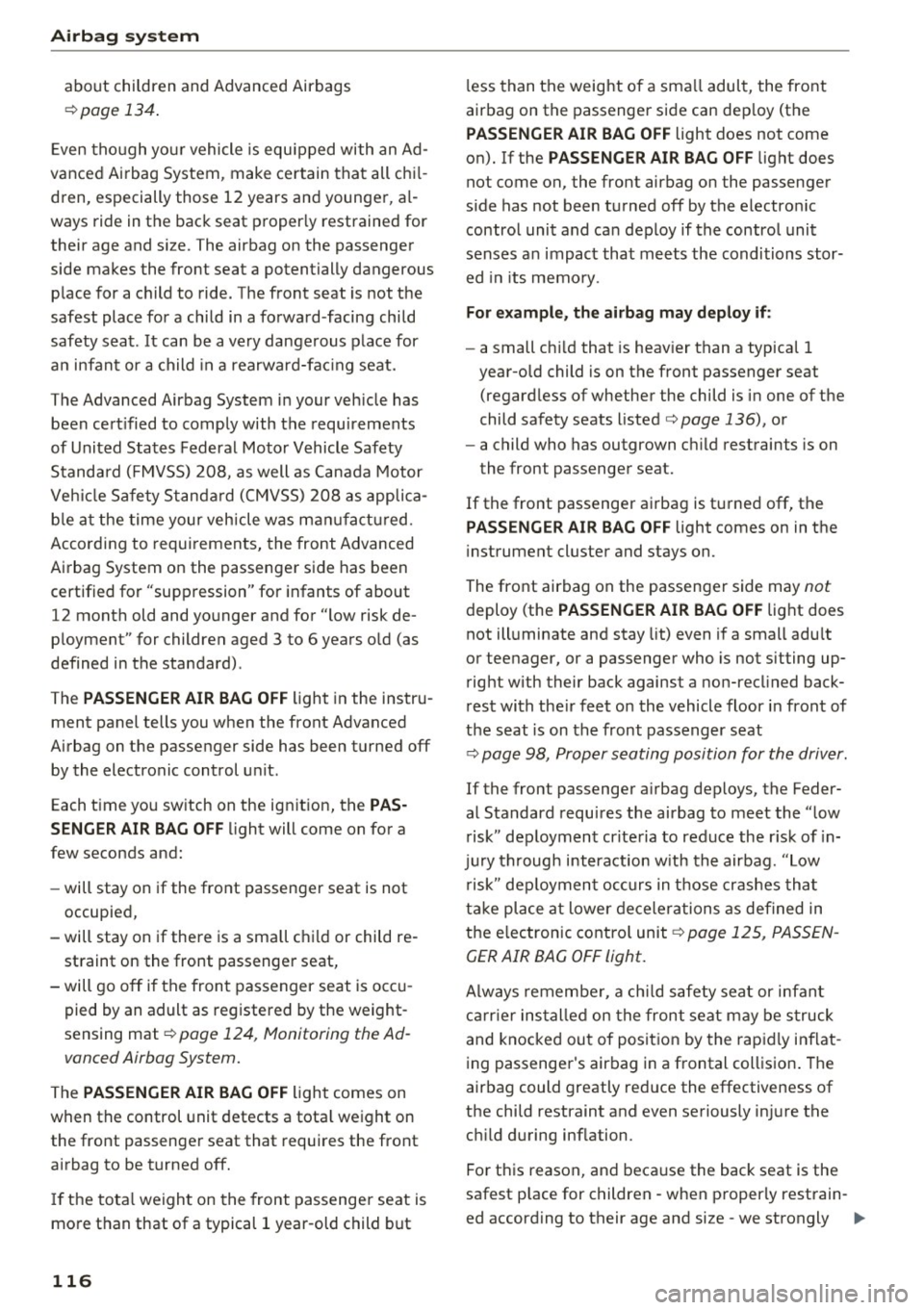
Airbag system
about children and Advanced Airbags
c:>page 134.
Even though your vehicle is equipped with an Ad
vanced Airbag System, make certain that all chil
dren, especially those 12 years and younger, al
ways ride in the back seat proper ly restrained for
their age and size. The airbag on the passenger
side makes the front seat a potentially dangerous place for a child to ride. The front seat is not the
safest place for a child in a forward-facing child
safety seat . It can be a very dangerous place for
an infant or a child in a rearward-fac ing seat.
The Advanced Airbag System in your veh icle has
been cert ified to comply with the requirements
of United States Federal Motor Vehicle Safety
Standard (FMVSS) 208, as well as Canada Motor
Veh icle Safety Standard (CMVSS) 208 as applica
b le at the time your vehicle was manufactured.
According to requirements, the front Advanced
Airbag System on the passenger side has been
certified for "suppression" for infants of about
12 month old and younger and for "low risk de
ployment" for children aged 3 to 6 years o ld (as
defined in the standard) .
The
PASSENGER AIR BAG OFF light in the instru
ment panel tells you when the front Advanced
Airbag on the passenger side has been turned off by the electronic control unit.
Each time you switch on the ignition, the
PAS
SENGER AIR BAG OFF
light will come on for a
few seconds and:
- will stay on if the front passenger seat is not
occupied,
-will stay on if there is a small chi ld or child re
straint on the front passenger seat,
- will go off if the front passenger seat is occu
pied by an adult as registered by the weight
sensing mat
c:> page 124, Monitoring the Ad
vanced Airbag System.
The PASSENGER AIR BAG OFF light comes on
when the control unit detects a tota l we ight on
the front passenger seat that requires the front
airbag to be turned off.
If the total weight on the front passenger seat is
more than that of a typical 1 year-old child but
116
less than the weight of a sma ll adult, the front
airbag on the passenger side can dep loy (the
PASSENGER AIR BAG OFF light does not come
on). If the
PASSENGER AIR BAG OFF light does
not come on, the front airbag on the passenger
s ide has not been turned off by the electron ic
control unit and can deploy if the control unit
senses an impact that meets the conditions stor
ed in its memory.
For example, the airbag may deploy if:
-a small ch ild that is heav ier than a typica l 1
year-old child is on the front passenger seat (regardless of whether the child is in one of the
child safety seats listed
c:> page 136), o r
- a child who has outgrown ch ild restraints is on
the front passenger seat.
If the front passenger airbag is turned off, the
PASSENGER AIR BAG OFF light comes on in the
i nstrument cluster and stays on.
The front airbag on the passenger side may
not
deploy (the PASSENGER AIR BAG OFF light does
not illuminate and stay lit) even if a small adult
or teenager, or a passenger who is not sitting up
right with their back against a non-reclined back
rest with the ir feet on the vehicle floor in front of
the seat is on the front passenger seat
c:> page 98, Proper seating position for the driver.
If the front passenger a irbag deploys, the Feder
al Standard requires the airbag to meet the "low
risk" deployment criteria to reduce the r isk of in
jury through interact ion w ith the airbag. "Low
risk" deployment occurs in those crashes that
take place a t lower decelerations as defined in
the e lectronic control unit
c:> page 125, PASSEN
GER AIR BAG OFF light.
Always remember, a child safety seat or infant
carrier installed on the front seat may be struck
and knocked out of position by the rapidly inflat
i ng passenger's airbag in a frontal collision . The
airbag could greatly reduce the effectiveness of
the child restraint and even seriously injure the
ch ild during inflation.
For this reason, and because the back seat is the
safest place for children -when proper ly restrain
ed according to their age and size -we strongly
Ill>
Page 119 of 230
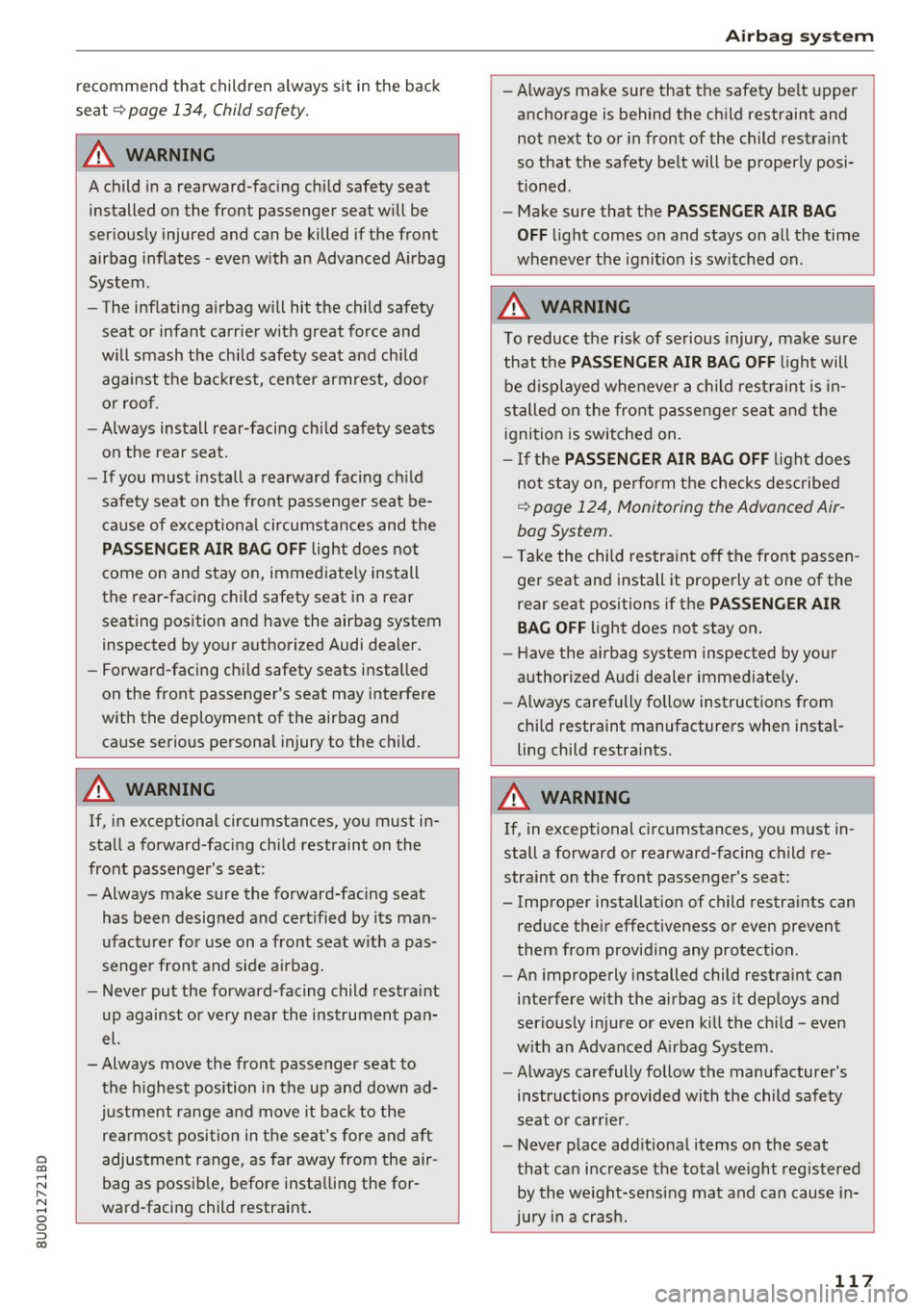
0 co ......
"' ,....
"' ...... 0 0 :::,
00
re commend that children a lway s sit in t he b ack
seat ~
page 134, Child safety .
A WARNING
A child in a rearward-faci ng chi ld safety seat
installed on the front passen ger seat w ill be
seriously injured and can be killed if the front airbag inflates -even w ith an Advanced A irbag
System .
- The inflating a irbag w ill hit the child safety
seat or infant carrier with great force and
will smash the ch ild safety seat and child
against the backrest, center armrest, door
o r roof.
- Always install rear-facing child safety seats
on the rear seat.
- If you must install a rearward fac ing ch ild
safety seat on the front passenger seat be
cause of exceptiona l circumstances and the
PASSENGER AIR BAG OFF light does not
come on and stay on, immed iate ly install
the rear-fac ing ch ild safety seat in a rear
seating posit ion and have the airbag system
inspected by your authorized Audi dea ler.
- Forward-fac ing ch ild safety seats installed
on the front passenger's seat may interfere
with the deployment of the airbag and cause serious personal injury to the child.
A WARNING
If, in except ional circumstances, you must in
stall a forward-facing chi ld restraint on the
front passenger's seat:
- Always make sure the forward-fac ing seat
has been designed and ce rtified by its man
ufacturer fo r use on a fron t seat with a pas
senger front and s ide a irbag.
- Never put the forward-facing child restraint
up against or ve ry near the instrument pan
el.
- Always move the front passenger seat to
the highest position in t he up an d down ad
justment range and move it b ack to the
re ar most position in the se at's fore and a ft
adjustment range, as far away from the air
bag as possib le, before insta llin g the for
ward-facing child restraint .
Airbag sys tem
-Always make sure that the safety be lt upper
anchorage is behind the ch ild restraint and
not next to or in front of the child restraint
so that the safety be lt will be properly posi
tioned .
- Make sure that the
PASSENGER AIR BAG
OFF
li ght comes on and stays on a ll the time
wheneve r the ignit ion is switched on.
A WARNING
-To reduce the risk of serious injury, ma ke sure
that the
PASSENGER AIR BAG OFF ligh t will
be d isplayed whenever a c hild rest raint is i n
st alle d on the front passenger seat and the
i gni tion is switched on.
- I f the
PASSENGER AIR BAG OFF light does
not stay on, perform the checks de scribe d
q page 124, Monitoring the Advanced Air
bag System .
- Take the child restra int off the front passen
ger seat and install it properly at one of the rear seat positions if the
PASSENGER AIR
BAG O FF
light does not stay on.
- Have the ai rbag system inspected by your
author ized Audi dealer immed iate ly .
- Always carefully follow instructions from
child restraint manufacturers when instal
ling child restra ints.
A WARNING
-If, in exceptional c ircumstances, you must in
stall a forward or rearward-facing child re
stra int on the front passenger's seat :
- Improper installat ion of child restraints can
reduce the ir effectiveness or even prevent
them from providing any protect ion.
- An improperly installed child restra int can
interfere with the airbag as it deploys and
serio usly injure or even ki ll the chi ld -even
with an Advanced A irbag Sys tem.
- Always carefully follow the manufacturer's
instr uctions provided with the child safe ty
seat o r ca rr ie r.
- Never p lace add itiona l items on the seat
that can increase t he total weight registered
by the weight-sensing mat and can caus e in
jury in a crash .
117
Page 120 of 230
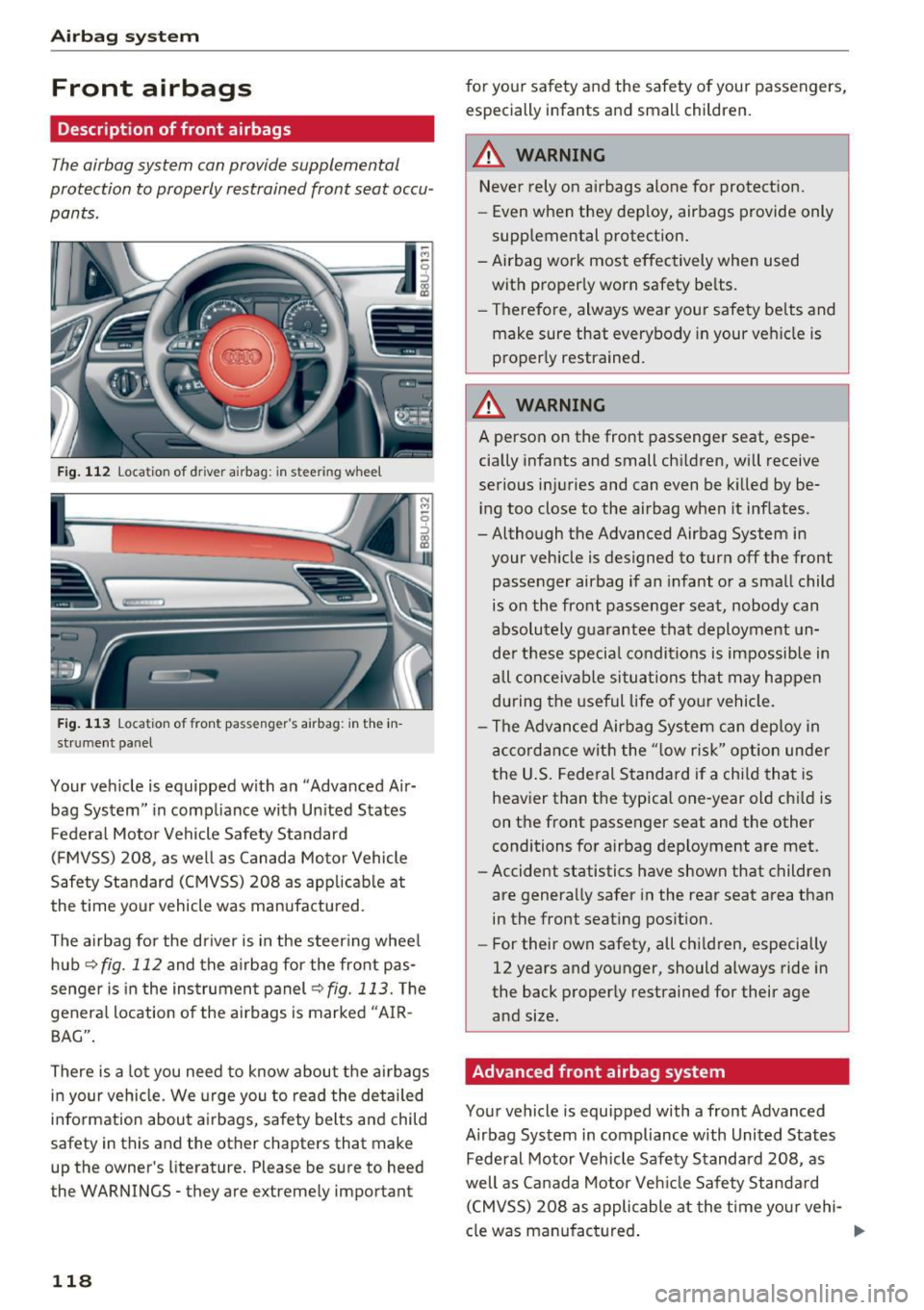
Airbag system
Front airbags
Description of front airbags
The airbag system can provide supplemental
protection to properly restrained front seat occu
pants.
Fig. 112 Location of driver airbag: in steering whee l
Fig. 113 Location of front passenger's airbag: in th e in
strument panel
Your veh icle is equipped with an "Advanced Air
bag System " in compliance with Un ited States
Federal Motor Vehicle Safety Standard
(FMVSS) 208, as well as Canada Motor Vehicle
Safety Standard (CMVSS) 208 as applicable at
the time your vehicle was manufactured.
The airbag for the driver is in the steer ing whee l
hub~
fig. 112 and the airbag for the front pas
senger is in the instrument panel
~fig. 113. Th e
general location of the airbags is marked "AIR
BAG" .
There is a lot you need to know about the airbags
in your vehicle . We urge you to read the detailed
information about airbags, safety belts and child
safety in this and the other chapters that make
up the owner 's literature. Please be sure to heed
the WARNINGS - they are extreme ly important
118
for your safety and the safety of your passengers,
especially infants and small children.
A WARNING -
Never rely on airbags alone for protection.
- Even when they deploy, airbags provide only
supplemental protection.
- Airbag work most effectively when used with proper ly worn safety belts.
- Therefore, always wear your safety be lts and
make sure that everybody in your veh icle is
proper ly restrained.
A WARNING
A person on the front passenger seat, espe
cially infants and small chi ldren, will receive
serious injuries and can even be killed by be ing too close to the airbag when it inflates.
- Although the Advanced Airbag System in
your veh icle is designed to turn off the front
passenger airbag if an infant or a small child
is on the front passenger seat, nobody can
absolutely guarantee that deployment un
der these special conditions is impossible in
all conceivable situations that may happen
during the useful life of your vehicle.
- The Advanced Airbag System can dep loy in
accordance with the "lo w risk" option under
the U.S. Federal Standard if a child that is
heavier than the typical one-year old chi ld is
on the front passenger seat and the other
conditions for airbag deployment are met.
-Accident statistics have shown that children
are generally safer in the rear seat area than
in the front seat ing position.
- For their own safety, all children, especially
12 years and younger, should always ride in
the back properly restrained for their age and size.
Advanced front airbag system -
Your vehicle is equipped with a front Advanced
Airbag System in compliance with United States
Federal Motor Vehicle Safety Standard 208, as
well as Canada Motor Vehicle Safety Standa rd
(CMVSS) 208 as applicable at the time your vehi
cle was manufactured .